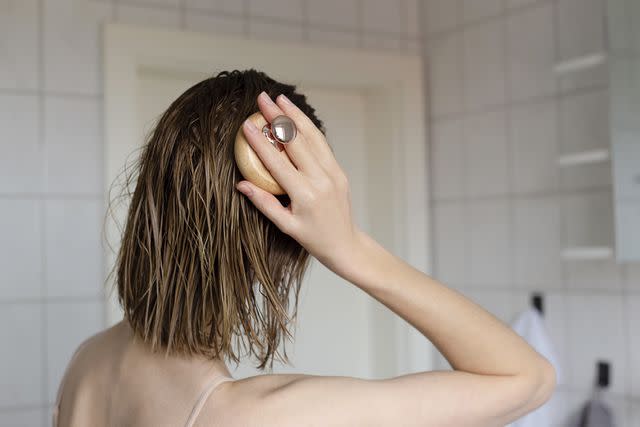Can a Scalp Massage Help With Hair Growth?
Medically reviewed by Brendan Camp, MD
A scalp massage is known for its ability to provide relaxation. Some research also supports its use to improve hair growth. A scalp massage can be done at home using your hands or a scalp massage tool.
This article will cover the benefits of a scalp massage, other hair growth tips, and who should avoid scalp massaging.

Valeriia Sviridova / 500px / Getty Images
Does a Scalp Massage Help Hair Growth?
There is limited research to support scalp massage for hair growth. Two studies do show the beneficial effects of massage. The first study, from 2016, found that scalp massage can increase hair thickness.
The study examined nine males who received a four-minute scalp massage with a massage device once daily for 24 days. It is believed that the massage caused mechanical stress on the dermal papilla cells, causing a change that increased hair thickness.
The second study, from 2019, supported the 2016 research and found that massage improved hair thickness in non-balding males.
These studies support the idea that massage can influence hair growth patterns. However, due to the small study size, more research is needed to support these findings.
Other Scalp Massage Benefits
Scalp massage not only improves hair thickness but also lowers stress hormones and blood pressure. A 2016 Journal of Physical Therapy Science study found that office workers who received scalp massages twice a week had lower blood pressure and stress hormones. The participants' heart rate did not significantly decrease but did show a small improvement.
Another benefit of scalp massage is that it can relieve migraines and tension headaches.
Migraines are severe headaches that cause significant pain on one side of the head. It can be accompanied by light sensitivity, nausea, and vomiting. A small study showed that massage in several areas, including the head, improved migraine symptoms. More research is needed to support these findings.
Tension headaches are the most common type of headache. It is pain felt in the head, often described as a band squeezing the head. It's typically caused by muscle tension in the area.
According to the American Massage Therapy Association, massage can treat tension headaches. The source recommends finding a professional massage therapist who is familiar with tension headache massage.
How to Massage Your Scalp
Massaging the scalp can be done at home at any convenient time. There is no standardized scalp massage guideline, but below describes how to use this self-care technique.
Traditional Scalp Massage
To perform a traditional scalp massage, use moderate pressure with the tips of the fingers against the scalp. Slowly press and move the fingers in circular motions. Move the fingers around the scalp, covering as much area as possible.
Other techniques use a kneading or tapping motion across the scalp. You can incorporate all these movements or choose which one you like best.
Massage While Washing Hair
Some people find that they prefer massaging their scalp while in the shower. The hair is wet, and they can use shampoo or conditioner to help glide their hands across the scalp.
Use the same techniques as a traditional scalp massage, with moderate pressure applied to the scalp with fingers moving in a circular motion.
Scalp Massage Tools and Brushes
Another option when performing a scalp massage is to use scalp massage tools or brushes. A scalp massager is a tool with small nubs or soft teeth used on the scalp while washing hair or showering. The gentle massage helps stimulate blood flow, lather shampoo, apply conditioner, and loosen flaky skin.
Some people may prefer to use a tool or a brush if their hands tire quickly or they just prefer the sensation that the tool or brush provides.
Scalp Massage With Essential Oils
Scalp massages can be a relaxing activity that can be enhanced with essential oils. Peppermint oil, in particular, has been researched for its hair growth benefits. A 2014 study looked at participants who were treated with saline, jojoba oil, peppermint oil, and Rogaine (minoxidil). Results showed that peppermint oil produced the best hair growth effects.
It's important to note that applying undiluted oil directly on the skin is not recommended because of the risk of irritation. Essential oils are often diluted in carrier oils, shampoos, or conditioners.
Learn More: Castor Oil for Hair Growth
Are There Disadvantages to Using a Scalp Massage for Hair Growth?
For many people, scalp massages provide a soothing activity that can also improve hair thickness. However, people with skin conditions of the scalp, scalp sensitivity, or skin damage should avoid or take precautions before performing a scalp massage.
Contact a healthcare provider before starting scalp massages if there are concerns about the skin on the scalp.
Learn More: 15 Different Ways to Take on Hair Regrowth
Other Tips for Hair Growth
Improving hair growth will not happen overnight. It takes time and treatment consistency. Below are tips to improve hair growth:
Use over-the-counter medication: This includes Rogaine.
Ask your healthcare provider about prescription medications: Oral medications include Proscar or Propecia (finasteride), Aldactone (spironolactone), and contraceptives.
Take preventive measures: Avoid tight hairstyles, harsh dyes, or chemical treatments that can damage the scalp and hair follicles.
Avoid nutritional deficiencies: Low levels of vitamin D, iron, and biotin can cause hair loss.
Do not excessively brush the hair: Too much stress on the hair can cause breakage.
Learn More: How to Prevent or Slow Down Continued Hair Loss
Summary
Scalp massage is a technique that has been shown to improve hair thickness. It can be performed at home during the regular hair care routine in or out of the shower. While scalp massage is generally considered safe, people with skin conditions or scalp sensitivities should talk to their healthcare provider before using scalp massage.
Read the original article on Verywell Health.

